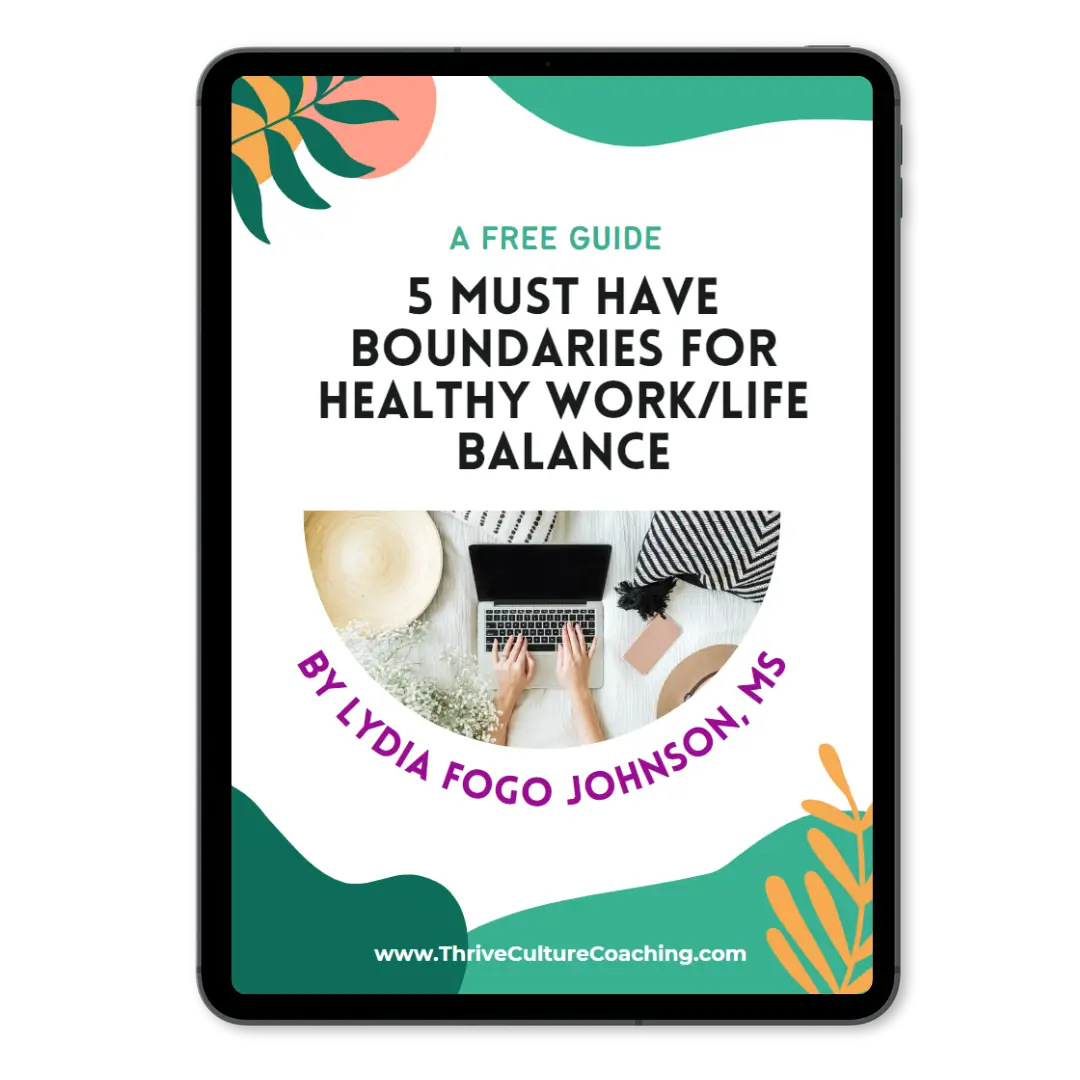Table of Contents
Does your coffee taste like disappointment? Does your to-do list feel less like a plan and more like an impossible mountain to climb?
If you’re dragging yourself through the day feeling utterly exhausted, I want you to hear me: You are not alone, and it is not your fault.
As a burnout coach, I’ve sat with so many brilliant, capable women who feel just like this. They feel trapped, believing the only way out is to quit their job and walk away from a career they’ve worked so hard to build.
But I’m here to tell you there is another way.
You don’t have to burn everything to the ground to enjoy your career again. This guide offers practical, powerful strategies on how to beat burnout without quitting your job, enabling you to reclaim your energy, joy, and career.
Ready to begin?
First, Let’s Gently Unpack Your Burnout
Burnout doesn’t appear overnight. It’s a slow burn, a gradual accumulation of too much output without enough input.
Think of it like a bank account: for months, or even years, you’ve been making constant withdrawals – meeting deadlines, managing projects, supporting your team, caring for your family – without making enough deposits back into your well-being.
Now, the account is overdrawn.
If you’re feeling this way, you’re in the majority.
Studies show that over 75% of workers have experienced burnout. It’s a collective experience born from a culture that often demands constant productivity. The emotional drain starts small but can grow until it impacts every aspect of your life, leaving you feeling cynical, detached, and ineffective.
The impact is worse on women, with data showing that women are more likely than men to experience burnout, at a ratio of 36% to 26% for women and men, respectively.
This is often compounded by what’s happening at home. Family responsibilities, mental clutter, and personal stressors don’t just disappear when you log on for work.
They add another layer of weight, creating a double burden that can feel impossible to carry. The anxiety builds until your resilience starts to crack. But understanding this is the first step toward healing.
10 Ways to Heal From Burnout Without Quitting Your Job
Burnout doesn’t have to mean hitting the eject button on your career. While a fresh start may sometimes be the right move, often healing and reclaiming joy in your current role is possible and deeply rewarding.
Here are ten ways to begin that recovery journey, rooted in science and real-world coaching experience, so you can restore your energy and rebuild your relationship with work without giving up what you’ve built.
1. Reset Your Nervous System
Burnout isn’t just in your head – it’s a physical state wired into your body by prolonged stress. When chronic work pressure becomes the norm, it can throw your entire nervous system out of balance, leaving you stuck on high alert.
Think of it as your body’s alarm system being jammed in the “on” position. This is often called the “fight or flight” response, and when it’s constantly active, it can cause very real symptoms: insomnia, a short fuse, trouble concentrating, and a bone-deep physical exhaustion that sleep alone won’t fix.
Research shows that chronic stress disrupts the natural rhythm of your stress hormones, such as cortisol, making it harder for your body to recover. This physiological wear and tear, sometimes referred to as “allostatic load,” directly affects your mood, energy, and even your long-term health.
But here’s the good news: your nervous system is resilient. With intentional daily practices, you can help it reset. Simple strategies like deep breathing, mindfulness, gentle movement, and prioritizing quality sleep activate your “rest and digest” system (the parasympathetic nervous system), which is responsible for recovery and healing.
These tools aren’t just “nice-to-haves”; they directly support your brain and body’s ability to recover, making mental clarity and physical energy possible again. This is the foundation for all other healing work.
Try this: Start with just 3 minutes of deep belly breathing each morning to calm your nervous system and set a peaceful tone for the day.
2. Rest, Relax, and Reclaim Joy Outside of Work
While you might want to spend more time working on your career, trying to get that promotion or increase your income, you’ve got to remember that your job is just one part of your life, and healing means permitting yourself to enjoy everything else again.
Schedule real breaks, unplug from work fully, and immerse yourself in hobbies, friendships, and activities that replenish your well.
Research has shown that rest is a key component in maintaining good mental health, preventing burnout, and ensuring long-term wellbeing.
Try this: Schedule one non-negotiable 30-minute activity this week that brings you joy—reading, walking, or calling a friend—and protect that time fiercely.
3. Assess Your Work-Related Stressors
While it generally feels like everything at work is stressing the life out of you, you want to get clear on exactly what’s causing your burnout. Is it an overwhelming workload, unclear expectations, toxic dynamics, or something else?
When you can name the specific stressors, you’re empowered to address them, whether that’s negotiating deadlines, seeking clarity, or advocating for support. Awareness is the first step toward change.
Try this: At the end of your workday, jot down one thing that caused you stress and one thing you enjoyed. After a week, look for patterns to address.
4. Examine Internal Mindset and Identity Stressors
A study by the University of Bath reveals that burnout is often fueled by perfectionism, even in the workplace.
Other factors include chronic people-pleasing and something called “work enmeshment” – when your job becomes inseparable from your identity.
This can make it hard to set limits or say no, even when you know you should.
Recognizing these internal patterns is crucial because it enables you to separate your self-worth from your work output and establish healthier boundaries that protect your energy.
Try this: When you catch yourself thinking “I must do this perfectly,” pause and ask: “What’s good enough here?” Practice permitting yourself to let go of perfection.
5. Realign Your Mindset to Prioritize You and Your Life
Our culture often equates success with relentless hustle. However, true success is sustainable and balanced. Redefine your career success not by your job title or to-do list, but by what truly fulfills you. Prioritize your well-being, joy, and relationships as much as your career achievements.
Try this: Identify three non-work-related aspects that define your self-worth. Revisit them daily to remember the entirety of who you are.
6. Implement Boundaries to Protect Your Time and Mind
Boundaries are your primary defense against burnout. To protect your time and mind, you must set them with intention. Establish firm time-based rules, like committing to a consistent end to your workday, and build mental firewalls to prevent work thoughts from invading your personal life.
This involves learning to say “no” respectfully, managing technology instead of letting it manage you, and creating simple rituals that signal the end of your day.
Try this: Choose a “stop work” time each day and set an alarm. When it goes off, shut down devices and switch to a relaxing non-work activity.
7. Get Support: You Don’t Have to Do This Alone
Trying to heal from burnout on your own is like trying to push a car uphill – it’s exhausting and unnecessary. The real value comes from leaning on others.
Start a straightforward conversation with your manager about your workload; you might be surprised by the solutions you find together. Connect with coworkers you trust to share experiences and feel less isolated. And don’t forget your friends and family, who can offer the emotional backup you need.
For truly personalized strategies, consider bringing in a professional. For example, you could work with a certified career and burnout coach such as myself. It’s incredible how much progress can be made when you have an unbiased expert helping you move forward with friendly accountability. Remember- You don’t get a prize for carrying the weight of the world by yourself.
Try this: Schedule one conversation this week – whether with your manager, a trusted colleague, or a friend – to share how you’re feeling and ask for support.
8. Ruthlessly Prioritize: Avoid Overdelivering
Saying yes to everything fuels burnout. Sharpen your ability to prioritize tasks that align with your goals and let go of or delegate the rest. For leaders, developing delegation and strategic planning skills will free you from micromanaging and constant firefighting. Quality over quantity in your work preserves your energy and effectiveness.
Try this: At the start of each day, pick your top three priorities. Delegate or defer everything else. Practice saying, “I won’t be able to take that on right now” once a day.
9. Improve Work Relationships Through Better Communication
When relationships at work are tense, they drain your energy and intensify feelings of burnout. The best way to address this issue is by improving communication. When you can clearly express expectations, manage disagreements constructively, and build genuine trust, your entire work experience improves.
Having a supportive community at work is one of the strongest protections against stress, and it starts with knowing how to handle difficult conversations with grace.
Try this: Prepare a short script for your next tricky conversation, focusing on “I” statements and specific requests, and practice it aloud beforehand.
10. Create a Sustainability Plan and Proactively Check In
Last but not least, burnout recovery isn’t a project you complete; it’s a practice you adopt. Develop a simple, personalized plan to stay on track. Use it to consistently check in on your well-being, adjust your boundaries as needed, and acknowledge your progress.
Your needs will evolve, so allow your plan to be flexible. Making these habits a regular part of your life is the key to ensuring your long-term balance and fulfillment.
Try this: Set a recurring weekly calendar reminder titled “Well-being Check-in.” Use it to reflect on what’s working, what’s not, and adjust your boundaries and self-care.
A Final Thought on Beating Burnout
You’ve just read through powerful, proven strategies for beating burnout. But reading an article is one thing; putting it into practice when you’re already exhausted is another challenge entirely.
I created this guide because I want you to know that healing is possible. You can feel engaged, energized, and happy in your work again without sacrificing your well-being.
If you’re ready for a supportive partner to guide you through this process, to help you set boundaries that stick, and to hold you accountable to your own well-being, I invite you to book a burnout coaching consultation call with me. As a quadruple-certified leadership, career, and burnout coach, I can help you understand precisely what has to change for you to love your career again.
FAQs on Burnout
You might still have some questions swirling in your mind. Let’s tackle a few common ones I hear in my practice.
What are the biggest warning signs that I’m burning out?
The most common signs I see are chronic exhaustion (a deep-seated fatigue that sleep doesn’t fix), a growing sense of cynicism or dread about your work, and feeling like you’re no longer effective at your job, even when you’re working harder than ever.
Can small changes in my daily routine really help with burnout?
Absolutely. Small changes are less intimidating and easier to sustain. Starting your day with five minutes of quiet time instead of instantly checking your email, taking a real lunch break away from your desk, or creating a 10-minute “wind-down” routine after work can have a massive cumulative impact on your stress levels.
I’m scared to tell my manager I’m experiencing burnout. What should I do?
This is a very real fear. My advice is to frame the conversation around solutions, not just problems. Focus on workload and process. Instead of saying “I’m burnt out,” you could say, “I’m committed to doing great work, and I’ve noticed that my current workload is becoming unsustainable. I’ve brainstormed a few ideas on how we could prioritize or streamline things, and I’d love to discuss them with you.” This positions you as a proactive problem-solver.




Share